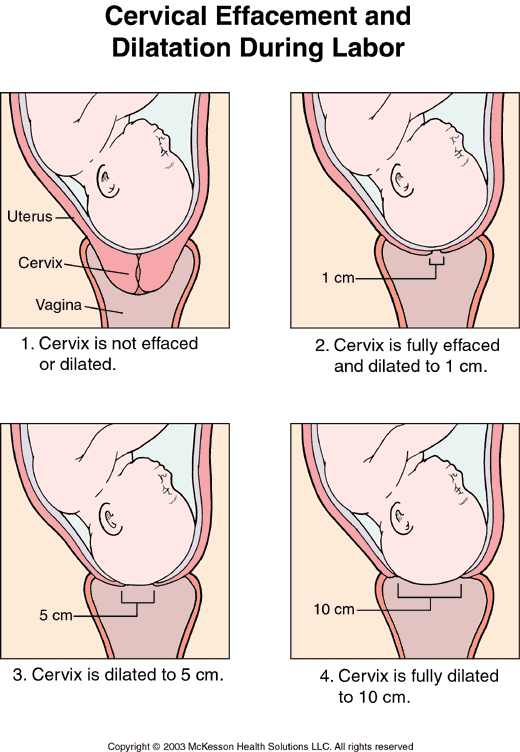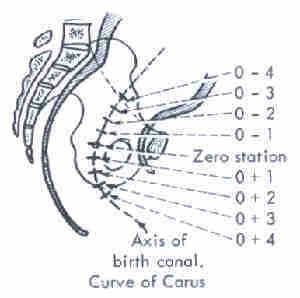And what is a vaginal exam? A woman's care provider inserts his or her two fingers into the vagina in order to ascertain the following information:
Ripeness: The cervix goes from being firm (like the tip of the nose) to soft (like the lips)
Dilation: How far the cervix has opened. It starts closed and opens to 10 cm
Effacement: The thickness or thinness of the cervix.
 Station: How far the baby is engaged in the pelvis. Measured in relation to the ishchial spines in the mother's pelvis. 0 station is engaged. Negative numbers means the baby is not engaged in the pelvis and postive numbers means the baby is past the ischial spines. +4 is on the perineum.
Station: How far the baby is engaged in the pelvis. Measured in relation to the ishchial spines in the mother's pelvis. 0 station is engaged. Negative numbers means the baby is not engaged in the pelvis and postive numbers means the baby is past the ischial spines. +4 is on the perineum.
Postion of baby: If the woman is far enough dilated, the baby's position can be ascertained by feeling for the fontanels (soft spots)
Position of cervix: The cervix moves from posterior to anterior
Now that we have a good idea of what exactly a VE is, let's look at vaginal exams during pregnancy. Care providers that practice within the medical model of care often start doing vaginal exams at 36-37 weeks of gestation. This can be a helpful practice, but is largely harmful. Let's look at the positive aspect of it. A woman may feel heartened to hear that her cervix is changing in preparation for birth. Especially if there is progress over the weeks leading up to birth. And encouragement is a great thing in those last, trying weeks of pregnancy.
Why is it harmful? From a physical standpoint, anytime anything foreign is inserted in the vagina, you run the risk of infection. There is an increased chance of rupture of membranes. But what I think is even more detrimental is the havoc it can wreak on a pregnant woman's emotions. It is not an accurate predicter of when labor will begin. The only thing a vaginal exam tells you is what is going on in your body at that moment. Many a woman has been largely discourged because she was 3 cm dilated at 37 weeks and is still 3 cm dialated at 40 weeks. Conversely, a woman's cervix can be closed and firm and she can have a baby a day later. And vaginal exams are often painful.
In the absence of a suspected problem, vaginal exams during pregnancy do more harm than good. If the goal is to satisfy curiosity, it is possible for a pregnant woman to check her own cervix. It is less risky this way, since we are accustomed to our own germs And it can be empowering for some woman. Why go to a doctor or midwife for information you could obtain for yourself?
I'll continue this post soon. Part II is Vaginal Exams during labor and birth
2 comments:
thank you this was very helpful. Though I understand it now, I wish I could have before. I am learning slowly but for most women, a VE is standard and in their mind necessary. Women are lead to believe in the 'power and accuracy of VE's' like they do in palm reading or the like. For me, it was easy to defer a VE until the last part of the pregnancies when my curious hormones and the falacies behind the necessity of VE's pulls me in.
So .... will most docs freak if you say "keep your two fingers to yourself?" .... or will a battle ensue?
Post a Comment